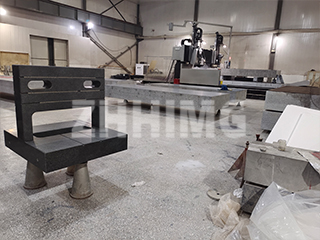A granite surface plate, also known as a granite inspection platform, is a precision reference measuring tool made from natural stone. It plays a critical role in machinery manufacturing, automotive, aerospace, chemical industry, hardware, petroleum, and instrumentation sectors. This durable platform is used as a reference base to detect workpiece errors, align and calibrate equipment, and perform both 2D and 3D scribing tasks.
Material Composition and Benefits
The granite used in inspection platforms is primarily composed of pyroxene, plagioclase, a small amount of olivine, biotite, and minor magnetite. These minerals give granite its:
-
Uniform black appearance
-
Dense structure
-
High hardness and compressive strength
-
Excellent dimensional stability
-
Resistance to wear, corrosion, and deformation
These characteristics make granite ideal for heavy-duty and high-precision measurement in industrial production and laboratory environments.
Key Features
-
High Precision
Granite surface plates are carefully machined and ground to achieve exceptional flatness and accuracy, meeting strict industry standards for precision measuring tasks. -
Excellent Stability
Granite’s inherent structural rigidity and resistance to thermal expansion ensure long-term dimensional stability, even in environments with temperature fluctuations. -
Wear Resistance
With its high surface hardness, granite is extremely resistant to scratches and abrasion, maintaining its accuracy over long-term use. -
Corrosion Resistance
Unlike metal plates, granite is inert to most chemicals, making it suitable for harsh industrial environments where exposure to oils, coolants, or acids is common.
How to Use a Granite Surface Plate
-
Select the appropriate size and grade based on your application.
-
Inspect the surface for visible damage or contamination.
-
Level the plate using precision leveling feet or stands.
-
Clean both the plate and the workpiece before measurement.
-
Place tools and components gently to avoid impact or damage.
-
Record measurements carefully, using compatible instruments like height gauges or dial indicators.
-
After use, clean the plate, inspect for wear, and store it in a dry, ventilated area.
Applications
Granite inspection plates are widely used for:
-
Surface flatness verification
-
Calibration of measuring instruments
-
Equipment setup and alignment
-
Machining accuracy checks
-
Part inspection and layout work
Conclusion
A granite surface plate is a high-precision, stable, and durable measurement tool that plays an essential role in modern manufacturing. When selecting a granite plate, consider the size, grade, and intended application. Proper use and maintenance will ensure long-term accuracy and reliable performance.
Whether you’re running a quality control lab or a high-performance manufacturing line, a granite inspection platform is an indispensable tool to ensure dimensional accuracy and process reliability.
Post time: Aug-01-2025

